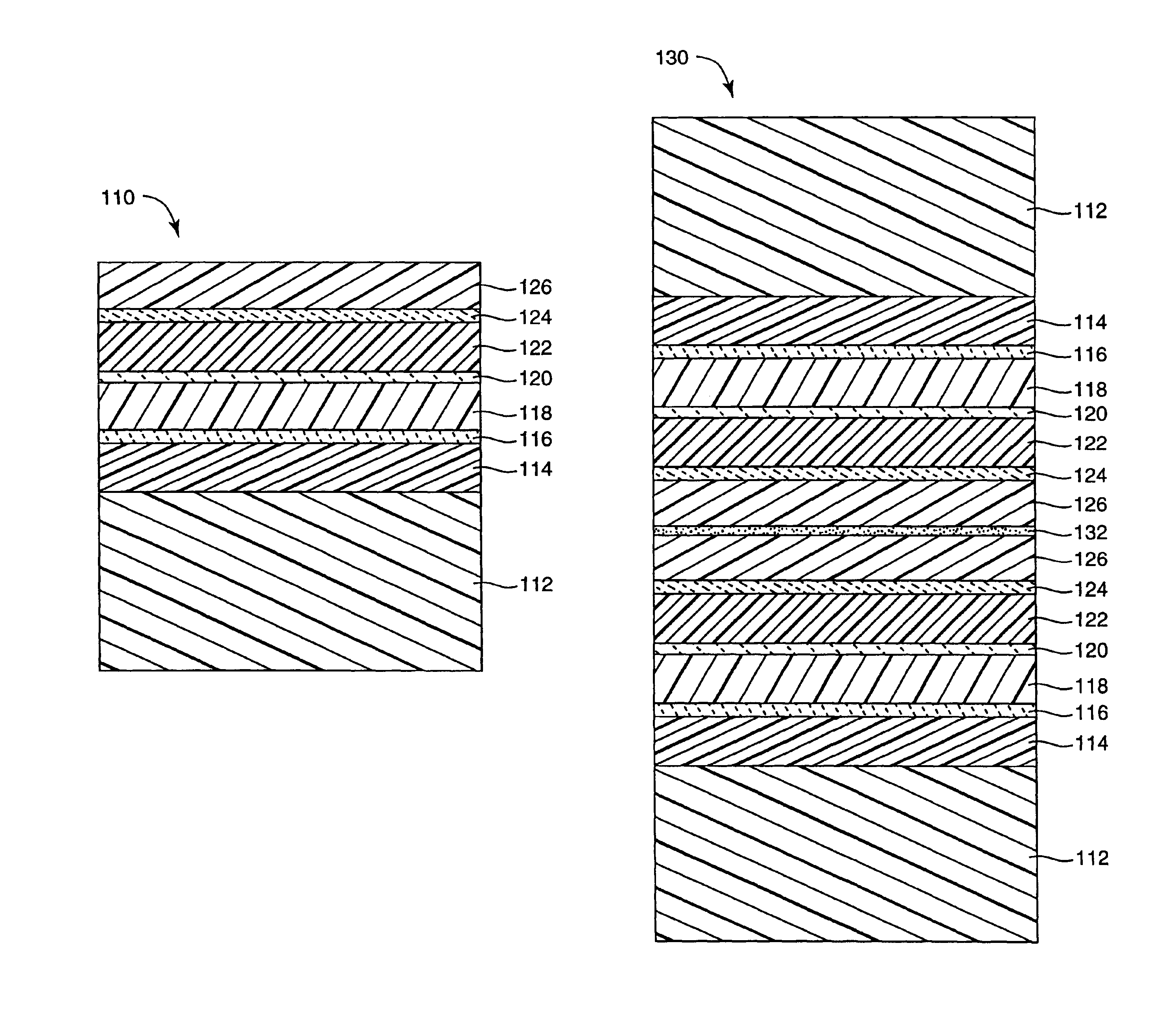Flexible high-temperature ultrabarrier
a high-temperature ultrabarrier and flexible technology, applied in the direction of instruments, final product manufacturing, sustainable manufacturing/processing, etc., can solve the problems of metals typically lacking transparency, glass lacking flexibility, and organic light emitting devices (oleds) suffering reduced output or premature failur
- Summary
- Abstract
- Description
- Claims
- Application Information
AI Technical Summary
Benefits of technology
Problems solved by technology
Method used
Image
Examples
example 1
[0043]A polyethylene naphthalate (“PEN”) support film was covered with a stack of acrylate and indium tin oxide (“ITO”) layers arranged in a seven layer alternating acrylate / ITO / acrylate / ITO / acrylate / ITO / acrylate configuration. The individual layers were formed as follows:
[0044](Layer 1) A 91 meter long roll of 0.127 mm thick×508 mm wide KALADEX™ 1020 PEN film (commercially available from Dupont-Teijin Films, Tg=120° C.) was loaded into a roll-to-roll vacuum processing chamber. The chamber was pumped down to a pressure of 8×10−6 torr. The film was treated with a nitrogen plasma operating at 600 W using a titanium cathode, using a web speed of 9.1 meters / min and maintaining the backside of the film in contact with a coating drum chilled to 0° C. Immediately after the plasma treatment and while the film was still in contact with the drum, the plasma-treated film surface was coated with an acrylate mixture prepared by combining 97% IRR-214 cyclic diacrylate (commercially available from...
example 2
[0053]A seven layer stack was prepared in the same manner as Example 1, but using SR-368D mixed acrylate mixture (commercially available from Sartomer Co. as a 50:50 mixture of SR-351 trimethylolpropane triacrylate and SR-368 tris (2-hydroxyethyl) isocyanurate triacrylate) and using no plasma treatment in the formation of Layers 3, 5, and 7. The estimated Tg of SR-368D is 167° C., based on an arithmetic average of the 62° C. Tg of SR-351 and the 272° C. Tg of SR-368.
[0054]The resulting seven layer stack exhibited an average spectral transmission Tvis=68% measured at a 30° angle of incidence, and a WVTR (determined at 50° C. and 100% RH) that was below the 0.005 g / m2 / day lower detection limit rate of the WVTR testing system.
example 3
[0055]A seven layer stack was prepared in the same manner as Example 1, but using MELINEX™ 617 polyethylene terephthalate (“PET”) film substrate (commercially available from DuPont-Teijin Films, Tg=70° C.) and different acrylates. Tripropylene glycol diacrylate (“TRPGDA”, commercially available from UCB Chemicals, Tg=62° C.) was used as the Layer 1 acrylate. A mixture containing 97% TRPGDA and 3% EBECRYL 170 acrylated acidic adhesion promoter and having an estimated Tg=62° C., was used to form Layers 3, 5 and 7.
[0056]The resulting seven layer stack exhibited an average spectral transmission Tvis=71% measured at a 30° angle of incidence, and a WVTR (determined at 50° C. and 100% RH) of 0.036 g / m2 / day.
PUM
| Property | Measurement | Unit |
|---|---|---|
| RH | aaaaa | aaaaa |
| Tg | aaaaa | aaaaa |
| Tg | aaaaa | aaaaa |
Abstract
Description
Claims
Application Information
 Login to View More
Login to View More - R&D
- Intellectual Property
- Life Sciences
- Materials
- Tech Scout
- Unparalleled Data Quality
- Higher Quality Content
- 60% Fewer Hallucinations
Browse by: Latest US Patents, China's latest patents, Technical Efficacy Thesaurus, Application Domain, Technology Topic, Popular Technical Reports.
© 2025 PatSnap. All rights reserved.Legal|Privacy policy|Modern Slavery Act Transparency Statement|Sitemap|About US| Contact US: help@patsnap.com



